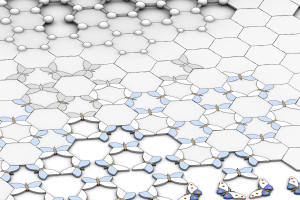Jun 2 2014
Combining black and white graphene can change the electronic properties of the one-atom thick materials, University of Manchester researchers have found.
 The Hofstadter butterfly has been an elusive phenomenon in physics
The Hofstadter butterfly has been an elusive phenomenon in physics
Writing in Nature Physics, a large international team led by Dr Artem Mishchenko and Sir Andre Geim from The University of Manchester shows that the electronic properties of graphene change dramatically if graphene is placed on top of boron nitride, also known as ‘white graphite’.
One of the major challenges for using graphene in electronics applications is the absence of a band gap, which basically means that graphene’s electrical conductivity cannot be switched off completely. Whatever researchers tried to do with the material so far, it remained highly electrically conductive.
A new direction that has recently emerged in graphene research is to try to modify graphene’s electronic properties by combining it with other similar materials in multilayered stacks. This creates an additional landscape for electrons moving through graphene and, therefore, its electronic properties can change strongly.
The University of Manchester scientists have used capacitance measurements to probe these changes. They found that in combination with a magnetic field this creates numerous replicas of the original graphene spectrum. This phenomenon is known as the Hofstadter butterfly but it is the first time that well developed replica spectra have been observed.
The researchers found a wealth of unexpected physics in this new system. For example, the Hofstadter butterflies turned out to be strongly contorted, very different from the theoretical predictions. This happens because electrons feel not only the landscape but also each other, which modifies the butterfly.
Another phenomenon that the Manchester paper reports is that graphene starts behaving at very low temperatures like a tiny ferromagnet. Usually, the higher the magnetic field, the more magnetic graphene become. The Hofstadter butterfly in Manchester’s capacitors leads to an unexpected oscillating behaviour of the ferromagnetism. As new replica spectra emerge and disappear, so does the ferromagnetism.
Dr Mishchenko said: “It is really a new nice electronic system both similar to and different from graphene. We expect many more surprises. Let us first understand what it is and then we start talking about possible applications.”
The Manchester paper is a collaboration that involved researchers from the University of Lancaster in the UK, National High-Field Laboratory in Grenoble in France, National Institute for Materials Science in Japan and University of Belo Horizonte in Brazil.